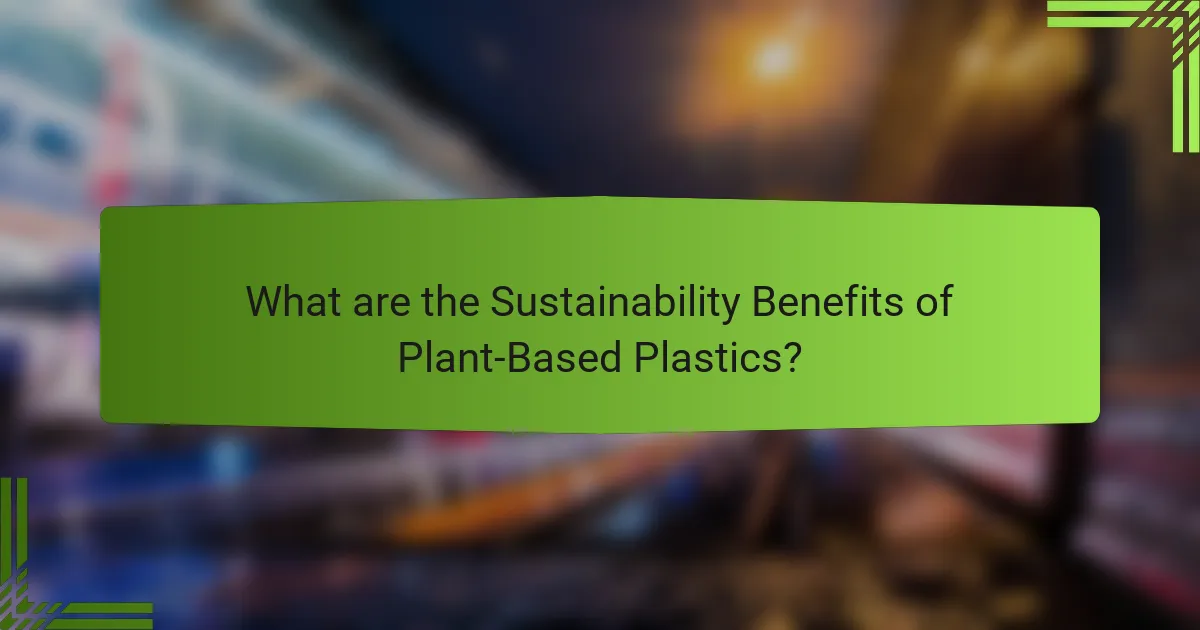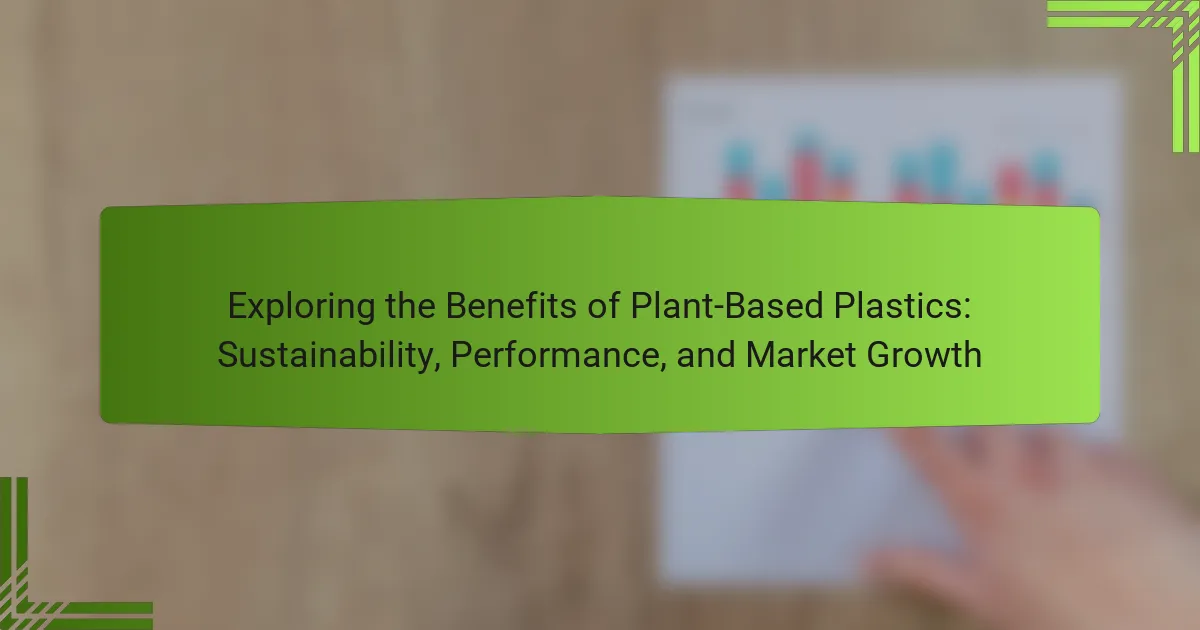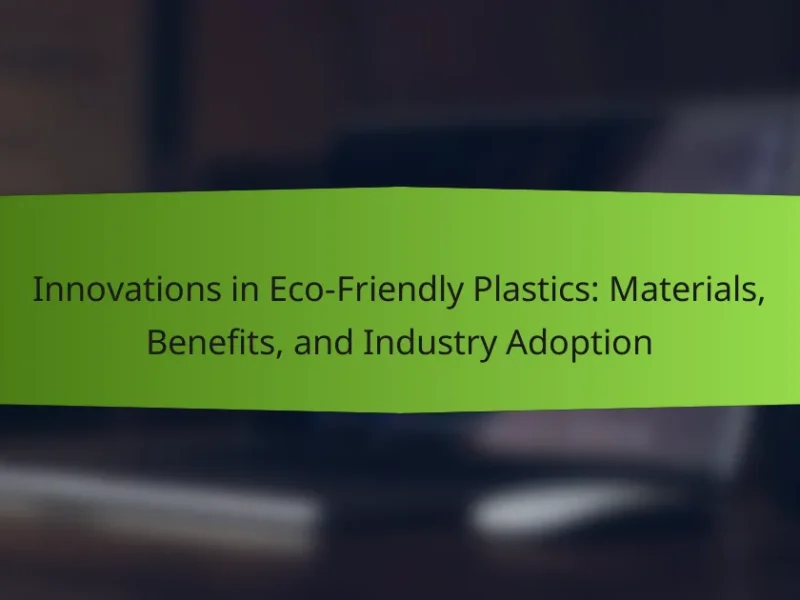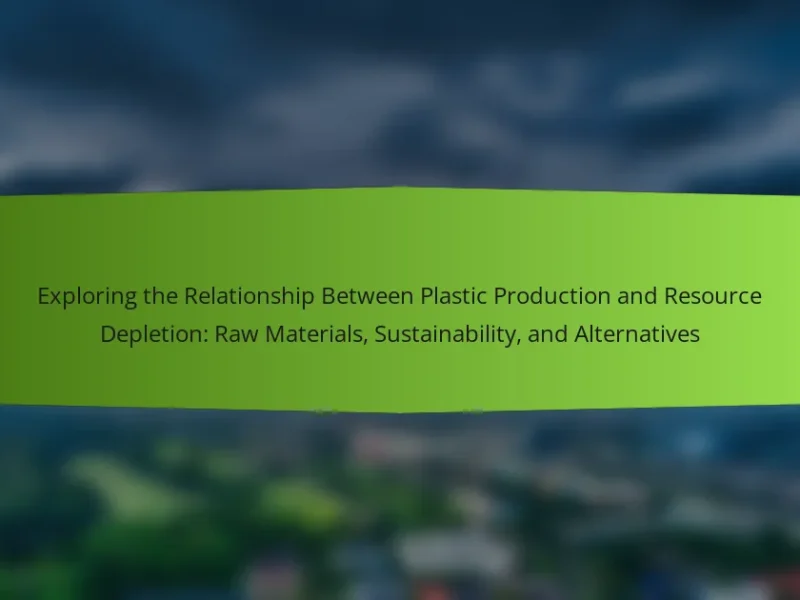Plant-based plastics are materials made from renewable biological sources such as corn, sugarcane, and potato starch, offering a sustainable alternative to traditional fossil fuel-based plastics. These materials can be biodegradable or compostable, contributing to reduced environmental impact and promoting a circular economy. The global market for bioplastics was valued at approximately $9.5 billion in 2020 and is expected to grow as consumers and businesses increasingly seek eco-friendly options. While plant-based plastics, like polylactic acid (PLA), exhibit performance characteristics similar to conventional plastics, including tensile strength and thermal stability, they may face challenges in moisture resistance and UV stability. Overall, plant-based plastics represent a significant advancement in sustainability and resource efficiency.

What are Plant-Based Plastics?
Plant-based plastics are materials derived from renewable biological sources. These sources include corn, sugarcane, and potato starch. Unlike traditional plastics made from fossil fuels, plant-based plastics aim to reduce environmental impact. They can be biodegradable or compostable, depending on their composition. For example, polylactic acid (PLA) is a common type of plant-based plastic made from fermented plant starch. Market growth for plant-based plastics has been significant, driven by increasing demand for sustainable alternatives. In 2020, the global bioplastics market was valued at approximately $9.5 billion. This figure is projected to grow as consumers and businesses seek eco-friendly options.
How are Plant-Based Plastics made?
Plant-based plastics are made from renewable resources, primarily derived from plants. The production process begins with extracting starch or cellulose from crops like corn or sugarcane. This raw material undergoes fermentation, converting the sugars into lactic acid. The lactic acid is then polymerized to create polylactic acid (PLA), a common type of plant-based plastic. Other methods may involve the use of natural oils or proteins. These materials can be molded and shaped similarly to conventional plastics. Plant-based plastics are biodegradable, offering an environmentally friendly alternative to petroleum-based plastics. Their production can reduce carbon emissions significantly compared to traditional plastic manufacturing.
What raw materials are used in the production of Plant-Based Plastics?
Plant-based plastics are primarily produced using raw materials derived from renewable sources. Common materials include corn starch, sugarcane, and potato starch. These materials undergo fermentation or polymerization processes to create bioplastics. For instance, polylactic acid (PLA) is made from fermented plant sugars. Additionally, other sources like cellulose and vegetable oils can also be utilized. These raw materials contribute to the biodegradability and reduced carbon footprint of plant-based plastics. Studies indicate that using renewable resources in plastic production significantly lowers greenhouse gas emissions compared to traditional petroleum-based plastics.
What processes are involved in converting these materials into plastics?
The processes involved in converting materials into plastics include polymerization, compounding, and molding. Polymerization is the chemical reaction that combines monomers to form polymers. This process can occur through methods like addition polymerization or condensation polymerization. Compounding involves mixing the polymer with additives to enhance properties such as strength, flexibility, and color. This step is crucial for achieving desired performance characteristics. Molding is the final process, where the compounded material is shaped into products using techniques like injection molding or extrusion. Each of these processes is essential for transforming raw materials into functional plastic products.
What distinguishes Plant-Based Plastics from traditional plastics?
Plant-based plastics are derived from renewable resources, unlike traditional plastics, which are petroleum-based. This fundamental difference in origin leads to varying environmental impacts. Plant-based plastics typically have a lower carbon footprint. They can be biodegradable or compostable, reducing long-term waste. Traditional plastics often persist in the environment for hundreds of years. Additionally, plant-based plastics can be produced with less energy. They often release fewer greenhouse gases during production. These distinctions highlight the sustainability benefits of plant-based plastics over traditional options.
What are the key differences in composition?
Plant-based plastics differ from conventional plastics in their composition. Plant-based plastics are derived from renewable biomass sources like corn, sugarcane, or potato starch. In contrast, conventional plastics are primarily made from fossil fuels, such as petroleum.
The chemical structure of plant-based plastics often includes polylactic acid (PLA) or polyhydroxyalkanoates (PHA). These polymers are biodegradable, unlike many traditional plastics that persist in the environment for hundreds of years.
Additionally, plant-based plastics typically have a lower carbon footprint during production. Research indicates that using renewable resources for production can reduce greenhouse gas emissions significantly.
Overall, the key differences lie in the source materials, chemical structure, biodegradability, and environmental impact.
How do their properties compare to conventional plastics?
Plant-based plastics generally exhibit different properties compared to conventional plastics. They often have lower carbon footprints due to renewable sourcing. Biodegradability is a significant advantage, allowing for reduced environmental impact. Conventional plastics typically do not decompose naturally, leading to long-term waste issues. Additionally, plant-based plastics can have varying mechanical properties. Some may be less durable than traditional plastics, while others can match or exceed their strength. Heat resistance in plant-based options can also differ, affecting their application range. Overall, the comparison highlights both advantages and limitations in performance and sustainability.

What are the Sustainability Benefits of Plant-Based Plastics?
Plant-based plastics offer significant sustainability benefits. They are derived from renewable resources, reducing reliance on fossil fuels. This shift helps lower greenhouse gas emissions during production. For instance, using corn or sugarcane as feedstock can cut emissions by up to 80% compared to traditional plastics. Additionally, plant-based plastics are often biodegradable or compostable. This means they can break down naturally, reducing landfill waste. Studies show that biodegradable plastics can decompose in industrial composting facilities within months. These properties contribute to a circular economy, promoting resource efficiency and waste reduction. Overall, plant-based plastics present a more sustainable alternative to conventional plastics.
How do Plant-Based Plastics impact the environment?
Plant-based plastics impact the environment by reducing reliance on fossil fuels. They are derived from renewable resources, such as corn or sugarcane. This results in lower greenhouse gas emissions during production compared to conventional plastics. Additionally, plant-based plastics can be biodegradable or compostable. This property helps reduce plastic waste in landfills. Studies indicate that using plant-based plastics can lead to a significant decrease in carbon footprint. For example, a life cycle assessment showed that bioplastics can reduce emissions by up to 30% compared to traditional plastics. Their production also promotes sustainable agricultural practices. Overall, plant-based plastics present a more environmentally friendly alternative to traditional petroleum-based plastics.
What are the carbon footprint implications?
Plant-based plastics generally have a lower carbon footprint compared to traditional petroleum-based plastics. Their production often results in reduced greenhouse gas emissions. For instance, studies indicate that plant-based plastics can cut carbon emissions by up to 50% during manufacturing. This reduction is primarily due to the utilization of renewable resources, like corn or sugarcane. Moreover, plant-based plastics can sequester carbon during the growth of these crops. This means they can offset some emissions throughout their lifecycle. Additionally, the end-of-life processing of plant-based plastics can lead to lower carbon emissions if composted properly. Overall, opting for plant-based plastics contributes to a significant decrease in carbon footprint.
How do they contribute to waste reduction?
Plant-based plastics contribute to waste reduction by being biodegradable and compostable. Unlike traditional plastics, which can take hundreds of years to decompose, plant-based plastics can break down in months under the right conditions. This property significantly lessens the accumulation of plastic waste in landfills and oceans. According to the Biodegradable Products Institute, compostable plastics can reduce landfill waste by 30% when used in conjunction with composting programs. Additionally, the production of plant-based plastics often utilizes renewable resources, reducing reliance on fossil fuels and minimizing environmental impact.
Why are Plant-Based Plastics considered a sustainable alternative?
Plant-based plastics are considered a sustainable alternative because they are derived from renewable resources. These resources include materials like corn, sugarcane, and potato starch. Unlike traditional plastics made from fossil fuels, plant-based plastics reduce dependence on non-renewable resources. They typically have a lower carbon footprint during production. Additionally, many plant-based plastics are biodegradable or compostable, reducing environmental impact. Research indicates that using plant-based materials can significantly decrease greenhouse gas emissions. For instance, a study by the European Bioplastics Association shows that bioplastics can cut carbon emissions by up to 80% compared to conventional plastics. This evidence supports the view that plant-based plastics are a viable and sustainable option.
What role do renewable resources play in their sustainability?
Renewable resources are crucial for sustainability as they provide an ongoing supply of materials without depleting natural reserves. They help reduce reliance on fossil fuels, which are finite and contribute to environmental degradation. By utilizing renewable resources, industries can lower greenhouse gas emissions. For example, plant-based plastics made from renewable sources can significantly reduce carbon footprints. According to a study by the Ellen MacArthur Foundation, transitioning to renewable materials could help reduce global plastic waste by 70% by 2040. This demonstrates the vital role renewable resources play in promoting sustainable practices and addressing climate change.
How do they affect biodiversity and ecosystems?
Plant-based plastics positively affect biodiversity and ecosystems by reducing reliance on fossil fuels. Their production often utilizes renewable resources, which can lead to lower greenhouse gas emissions. This reduction helps mitigate climate change, a significant threat to biodiversity. Additionally, plant-based plastics are generally biodegradable. This property allows them to break down more naturally in the environment compared to conventional plastics. Studies indicate that biodegradable plastics can decompose within a few months to years, minimizing long-term pollution. Furthermore, using agricultural waste for production can enhance soil health and promote sustainable farming practices. This approach supports ecosystem balance and biodiversity by maintaining healthy habitats.

What is the Performance of Plant-Based Plastics?
Plant-based plastics generally exhibit performance characteristics similar to conventional plastics. They can provide comparable tensile strength and flexibility. For example, polylactic acid (PLA), a common plant-based plastic, has a tensile strength of about 50 MPa. This strength is adequate for various applications, including packaging and disposable items.
Plant-based plastics also demonstrate good thermal stability. They can withstand temperatures up to 60°C before deforming. Additionally, they are biodegradable under specific conditions, reducing environmental impact. Research indicates that PLA can decompose in industrial composting facilities within 90 to 180 days.
However, some plant-based plastics have limitations in moisture resistance and UV stability. These factors can affect their durability in outdoor applications. Overall, the performance of plant-based plastics continues to improve with advancements in material science.
How do Plant-Based Plastics perform in various applications?
Plant-based plastics perform effectively in various applications, offering comparable properties to traditional plastics. They are used in packaging, automotive parts, and consumer goods. In packaging, they provide moisture resistance and durability. Automotive applications benefit from their lightweight nature and reduced carbon footprint. Consumer goods often utilize plant-based plastics for their safety and biodegradability. Research shows that plant-based plastics can achieve similar strength and flexibility as petroleum-based counterparts. For instance, a study published in the Journal of Cleaner Production indicates that specific bioplastics can meet industry standards for performance.
What are their mechanical properties compared to traditional plastics?
Plant-based plastics exhibit different mechanical properties compared to traditional plastics. They often have lower tensile strength and impact resistance. However, some plant-based plastics can be engineered to enhance these properties. For instance, polylactic acid (PLA) has a tensile strength of about 50 MPa, which is lower than conventional polyethylene at approximately 30 MPa. Additionally, plant-based plastics can have better biodegradability, which is an important factor in their mechanical performance over time. Research has shown that the flexibility of plant-based plastics can be improved through additives, making them more competitive with traditional options.
How do they fare in terms of durability and usability?
Plant-based plastics generally exhibit good durability and usability. They can withstand various environmental conditions, similar to traditional plastics. Many plant-based plastics are designed for specific applications, enhancing their usability in diverse industries. For instance, polylactic acid (PLA) is commonly used in packaging due to its strength and clarity. Additionally, studies show that some plant-based plastics can be as durable as conventional plastics, providing comparable performance metrics. Research indicates that certain formulations improve impact resistance and thermal stability, making them suitable for a range of applications. Overall, the advancements in plant-based plastic technology contribute positively to their durability and usability.
What challenges exist regarding the performance of Plant-Based Plastics?
Plant-based plastics face several performance challenges. These include lower mechanical strength compared to conventional plastics. They often exhibit higher moisture sensitivity, which can affect durability. Additionally, plant-based plastics may have limited heat resistance. Their biodegradability can lead to concerns about long-term storage and shelf life. The production process can also be less efficient, impacting scalability. Variability in raw materials can affect consistency in performance. Lastly, cost competitiveness remains a significant hurdle against traditional plastics.
What limitations do they have in specific environments?
Plant-based plastics have limitations in specific environments due to their sensitivity to temperature and humidity. For example, they may degrade more quickly in high heat or moisture conditions compared to traditional plastics. This makes them less suitable for outdoor applications in extreme climates. Additionally, some plant-based plastics may not perform well in high-stress mechanical environments, leading to potential failure. Their biodegradability can also be a limitation in environments lacking appropriate composting facilities. Research indicates that these materials require specific conditions to break down effectively. Therefore, improper disposal could lead to environmental concerns similar to conventional plastics.
How are manufacturers addressing these challenges?
Manufacturers are addressing challenges in plant-based plastics through innovation and collaboration. They are developing new formulations that enhance performance characteristics. This includes improving biodegradability and mechanical strength. Manufacturers are also investing in research to optimize production processes. They collaborate with academic institutions for advanced material studies. Additionally, they are exploring sustainable sourcing of raw materials. This ensures a consistent supply chain for plant-based inputs. These strategies help manufacturers overcome market barriers and increase adoption rates.
What are the market trends for Plant-Based Plastics?
The market trends for plant-based plastics indicate significant growth and increased adoption. The global market for plant-based plastics is projected to reach USD 44.93 billion by 2028, growing at a CAGR of 13.8% from 2021. This growth is driven by rising consumer demand for sustainable materials. Industries such as packaging, automotive, and consumer goods are increasingly incorporating plant-based plastics. Innovations in production processes are enhancing the performance and affordability of these materials. Regulatory support is also fostering market expansion, as governments promote eco-friendly alternatives. Additionally, major brands are committing to sustainability goals, further boosting demand for plant-based plastics.
How is the demand for Plant-Based Plastics evolving?
The demand for plant-based plastics is rapidly increasing. This growth is driven by rising environmental concerns and regulatory pressures. Consumers are seeking sustainable alternatives to traditional plastics. According to a report by Grand View Research, the global plant-based plastic market is expected to reach $44.93 billion by 2028. This represents a compound annual growth rate (CAGR) of 19.5% from 2021 to 2028. Companies are investing in research and development for innovative plant-based materials. Additionally, advancements in technology are enhancing the performance characteristics of these plastics. As a result, more industries are adopting plant-based plastics for packaging and product applications.
What industries are leading the adoption of Plant-Based Plastics?
The packaging, automotive, and consumer goods industries are leading the adoption of plant-based plastics. The packaging industry utilizes these materials for sustainable packaging solutions. In 2021, the global plant-based packaging market was valued at approximately $22 billion. The automotive industry incorporates plant-based plastics for lightweight components. This helps improve fuel efficiency and reduce carbon emissions. Consumer goods companies are increasingly using plant-based plastics for products like bottles and containers. This shift aligns with growing consumer demand for eco-friendly products.
What are best practices for using Plant-Based Plastics?
Best practices for using plant-based plastics include selecting appropriate types for specific applications. Use biodegradable options when compostability is desired. Ensure proper disposal methods to maximize environmental benefits. Educate consumers on the differences between plant-based and conventional plastics. Collaborate with suppliers to source sustainable materials. Monitor the lifecycle impacts of products made from plant-based plastics. Research shows that proper management can reduce carbon footprints significantly. Implementing these practices enhances sustainability and performance in various industries.
Plant-based plastics are materials derived from renewable biological sources, such as corn, sugarcane, and potato starch, aimed at reducing environmental impact compared to traditional fossil fuel-based plastics. This article explores their production processes, sustainability benefits, and performance characteristics, highlighting their potential for biodegradability and lower carbon footprints. It also examines market trends, industry adoption, and best practices for utilizing plant-based plastics effectively, emphasizing their role in promoting eco-friendly alternatives in various sectors. Key differences in composition and mechanical properties compared to conventional plastics are discussed, alongside the challenges and innovations shaping their future in the market.


